Effective Strategies for Clearing Bathtub Clogs
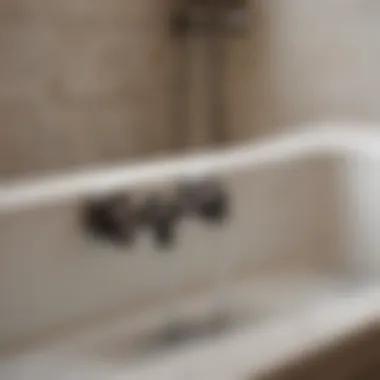
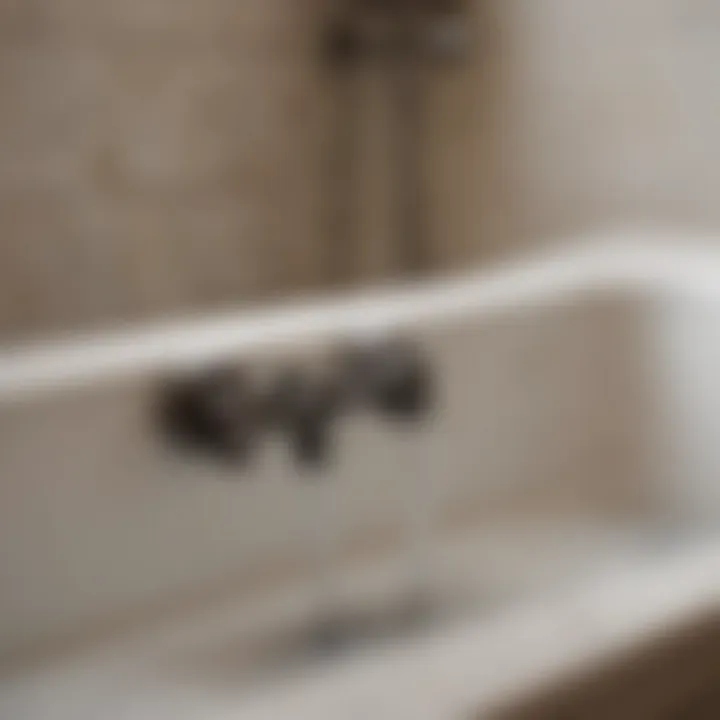
Intro
Dealing with bathtub clogs is a common headache for homeowners. The thought of tackling a stubborn blockage can sometimes feel overwhelming. However, understanding the source of these clogs is the first step towards effective resolution. Hair, soap scum, and mineral buildup often contribute to these pesky situations. Knowing how to remove clogs can save not only time but also money on potential plumbing services. This guide aims to help you become self-sufficient in maintaining your bathtub's plumbing with a range of effective techniques.
Before diving into the remedies, it’s crucial to recognize the importance of prevention. Keeping your bathtub clean can reduce the likelihood of clogs forming in the first place. Let’s explore some simple yet effective strategies tailored for anyone, regardless of their prior experience with home maintenance.
Common Causes of Bathtub Clogs
Knowing what causes clogs is half the battle. Here are some prevalent culprits:
- Hair: Long and short strands alike can trap in the drain, forming a tangled mess.
- Soap Scum: Build-up from soap bars or body wash can coat pipes, narrowing pathways.
- Mineral Deposits: Hard water can lead to calcification inside pipes.
Understanding these factors gives you the knowledge to effectively combat the issues.
Effective Techniques for Clogs Removal
Now that we understand the common causes, let’s delve into some effective techniques for removing bathtub clogs. Each method varies in complexity but offers a practical solution for homeowners.
1. The Boiling Water Method
Sometimes, the simplest methods are the most effective. Boiling water can dissolve soap scum and dislodge minor blockages. Here's how:
- Boil a pot of water.
- Carefully pour it down the drain in stages, giving it time to work its magic.
- Repeat as necessary.
Quick Tip: Always make sure your drain can handle hot water, especially if it's an older model. Some materials can warp under high temperatures.
2. Baking Soda and Vinegar
This classic combination is not just for cleaning; it can also work wonders for clogs.
- Pour half a cup of baking soda down the drain.
- Follow it with half a cup of vinegar.
- Allow the mixture to fizz for about 30 minutes and then flush with hot water.
3. The Plunger Technique
While it may seem like a tool only for toilets, a plunger can also be quite handy in bathtubs.
- Ensure the drain is covered with water (depth of an inch or so).
- Place the plunger over the drain and pump vigorously several times.
- This should create a suction effect, loosening the clog.
4. Drain Snake
If the clog remains elusive, you might consider investing in a drain snake. This device can reach deep into the pipes to pull out hair and debris.
- Insert the snake into the drain.
- Rotate while pushing the snake further down. Once you feel resistance, pull it out carefully.
- Repeat as needed.
5. Professional Help
If you've tried all these methods without success, it might be time to call in a professional plumber. Issues such as tree roots in the pipes or serious buildup may require specialized equipment.
Preventive Measures
To maintain your bathtub and keep clogs at bay, consider these preventive steps:
- Regularly clean the drain with baking soda and vinegar.
- Use a drain cover to catch hair and debris before it enters the drain.
- Rinse the bathtub after each use to minimize soap residue.
By implementing these suggestions, you can help ensure that bathtub clogs become a rare occurrence rather than a regular dilemma.
In sum, dealing with bathtub clogs doesn't have to be a daunting task. With a clear understanding of causes and methods, homeowners can tackle these issues head-on. Keep the plumbing in tip-top shape, and your drain will thank you.
Understanding Bathtub Clogs
Understanding bathtub clogs is fundamental to maintaining the functionality of your bath space. Clogs can transform a soothing soak into a frustrating experience, affecting not just comfort but also the overall health of your plumbing system. Knowing what leads to these blockages allows homeowners to act effectively, whether it’s taking preventive measures or addressing problems promptly.
Recognizing different types of clogs enables you to choose the appropriate remedy, minimizing damage and costs associated with persistent issues. Being informed equips you to make smarter decisions about your home, thereby enhancing both your living environment and property value.
Types of Bathtub Clogs
When clogs occur, they typically stem from a few common culprits. Identifying these types helps in devising effective solutions.
Hair buildup
Hair buildup is one of the most common offenders when it comes to bathtub clogs. It accumulates from daily use as strands are washed down the drain. The key characteristic of hair is its ability to tangle and form mats, which can easily cling to the inside of pipes. This makes it a prevalent issue in households, especially those with long hair.
The unique feature of hair clogs is that they tend to progress gradually rather than causing an immediate blockage. This gradual buildup can lead to more significant issues, such as slow drainage or complete clogs, which can be quite a nuisance.
Soap scum
Soap scum, the byproduct of soap reacting with minerals in water, is another notorious clog creator. It has a sticky texture and builds up on surfaces over time, contributing to drainage issues. One notable characteristic of soap scum is its accumulation in areas that are frequently exposed to moisture, enhancing its likelihood of causing blockages.
While soap scum alone may not seem as serious as other types of clogs, it can combine with other debris, creating a formidable blockage. This makes understanding soap scum important in providing a holistic approach to preventing clogged drains.
Mineral deposits
Mineral deposits, also known as limescale, appear in areas with hard water. This buildup can occur inside pipes and on fixtures, constricting water flow over time. The primary characteristic of mineral deposits is their stubbornness; once they form, they can be quite difficult to remove. Understanding these deposits is crucial because they not only impede drainage but can also damage plumbing over time.
These deposits can masquerade as simple nuisance but can lead to bigger issues with plumbing efficiency. If ignored, mineral buildup can necessitate costly repairs and replacements, making it worth your while to address this aspect.
Foreign objects
Foreign objects are potentially the most unpredictable type of clog. These can be anything from children’s toys to cotton swabs that mistakenly find their way into the drain. The aspect of foreign objects that is particularly troublesome is their diverse nature; each object poses a different challenge.
Their key characteristic is unpredictability, as they can vary in size, shape, and material. Understanding the implications of foreign clogs is vital—while some can be easily removed, others require professional intervention, especially if they are deeply lodged within the plumbing.
In summary, each type of clog has unique attributes and implications for plumbing maintenance. By comprehending these different forms of clogs, you can better navigate the path to effective remedies and preventive strategies.
Common Causes of Clogs
Understanding the common causes of bathtub clogs is crucial for tackling the plumbing woes that many homeowners face. By recognizing these culprits, individuals can proactively minimize the risks associated with clogs. Ignoring such issues can lead to costly repairs and extensive damage.
At times, it may feel as if clogs spring up out of the blue, but many of them stem from predictable daily habits or the gradual deterioration of plumbing systems. This section provides a deeper dive into the leading contributors to clogs, informing effective strategies for prevention and remediation.
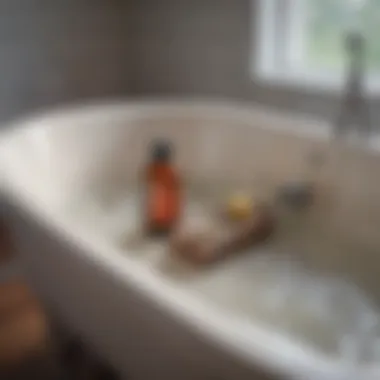
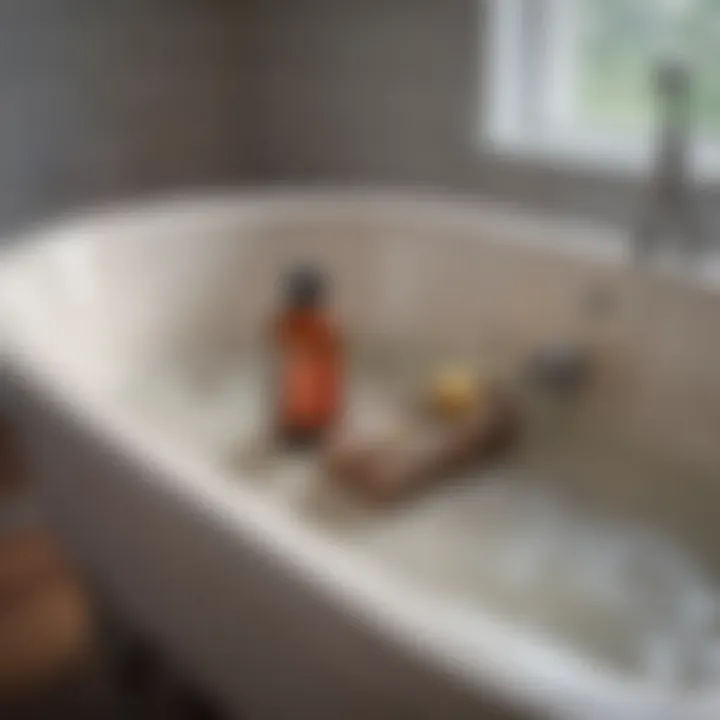
Daily Bathroom Habits
Shedding hair
Shedding hair is one of the most significant contributors to bathtub clogs. Like it or not, our hair inevitably ends up in the drain due to normal washing or bathing. The key characteristic of this is that it tends to tangle and bind together with other debris, creating a dense mass that effortlessly blocks water from flowing. While it may seem benign at first—just a few strands here and there—it can turn into a significant headache over time.
The unique feature of hair shedding is that it is an everyday occurrence that can easily be overlooked, thus making it a common and beneficial option to address in any discussion on clogs. Its disadvantage, however, lies in the fact that once it starts to build up, it becomes increasingly challenging to remove without the right tools.
Use of heavy soaps
Heavy soaps are another troublesome factor that can clog drains. Many people enjoy rich, creamy body washes or soaps that promise deep hydration. These products often contain oils and other substances that can leave behind a residue. The key characteristic of heavy soaps is their tendency to accumulate over time, especially when mixed with hair and other debris. Hence, this can compound issues that begin at the drain.
Utilizing heavy soaps might feel luxurious, but the unique feature here is that they often do double duty as a potential clogging agent. While nice to use, their disadvantage is that they require more frequent cleaning of the drain area to prevent buildup, especially for those who bathe regularly.
Improper disposal of items
Many people may not think about what goes down the drain beyond just water and soap. Improper disposal of items—like cotton swabs, hair ties, or even remnants of small toys—can create havoc in plumbing systems. This is where people often neglect to consider the impact of their actions.
The key characteristic of this behavior is that items which are not meant for plumbing tend to accumulate, creating blockages. The unique feature is that it's often not even a thought in individuals’ minds until it’s too late. The disadvantage of improper disposal is that the resulting clogs can sometimes become significant enough to require professional help to clear, creating longer waiting times and more frustration.
Pipe Condition and Aging
Corrosion
Corrosion is a natural phenomenon that occurs gradually over time, ultimately impacting the integrity of pipes. This process often leads to tiny holes or blockages due to rust, contributing to water drainage issues. The key characteristic of corrosion is that it tends to start slowly and become progressively worse, which makes it somewhat insidious.
While most homeowners may not directly correlate poor water flow with corrosion, recognizing it as a potential cause is vital. The unique feature of corrosion is that it can lead to leaks if left unaddressed. On the downside, repairing corroded pipes can be a costly endeavor, often requiring professional intervention.
Scale buildup
Scale buildup occurs when minerals from hard water settle in the pipes. Over time, these deposits accumulate and can restrict the flow of water, leading to clogs. What’s interesting about scale is its formation usually goes unnoticed until there’s a noticeable change in drainage speed. The key characteristic of scale buildup is that it is a gradual process, which gives homeowners a false sense of security.
The unique feature of this issue is how some regions face more significant problems due to water quality. Unfortunately, while you can combat hard water with certain treatments, this matter often leads to inevitable repairs in aging plumbing.
Pipe integrity issues
Aging pipes lose their ability to maintain structural integrity as the years pass. Cracks, leaks, and misalignments can become commonplace, allowing debris to escape into the drainage system and create blockages. The key characteristic here is that many homes—especially older ones—may have unseen vulnerabilities.
The unique aspect of pipe integrity issues lies in their unpredictable nature. They might not show immediate effects but can lead to serious problems down the line, such as severe clogs or even burst pipes. This drawback underscores the importance of regular inspections to prevent potential disasters.
Prevention Techniques
When it comes to the unfortunate reality of bathtub clogs, prevention is not just better than cure; it's often the only way to avoid a plumbing disaster. The importance of adopting effective prevention strategies cannot be overstated, as they provide a proactive approach to maintain your plumbing’s health, ultimately saving you time and money down the road.
Bathtub clogs can often lead to further complications, including water damage to your home and unnecessary repair expenses. Regular preventive techniques can thwart common issues before they escalate into significant problems. It’s a no-brainer: think of it like oil changes for your car or routine check-ups with your doctor. Regular investments in maintenance can help you avoid costly surprises later on.
Regular Maintenance
Routine cleaning
When talking about routine cleaning, it's about consistency and diligence. Regularly cleaning your bathtub not only helps stave off the buildup of hair, soap scum, and mineral deposits but also makes any potential clogs easier to tackle before they hinder your bathing experience. A simple weekly scrub with an appropriate non-abrasive cleaner can work wonders, keeping surfaces clear and drains flowing.
One noteworthy characteristic of routine cleaning is its accessibility; all it takes are basic cleaning supplies that most of us already have at home. That makes it a popular choice among homeowners. Despite its simplicity, it might not seem glamorous, but consistent upkeep can save you from major headaches down the line.
The unique feature of routine cleaning is that it acts as a preventative buffer. Regularly scheduled cleaning helps lengthen intervals between clogs forming—think of it as keeping the door shut before unwanted guests invite themselves over. Most importantly, it is low-cost; the only major downside may be the commitment to maintain a regular schedule, but it truly pays off.
Inspection methods
Inspection methods play a crucial role in identifying potential trouble spots before they turn into real issues. A simple visual check for signs of wear and tear can reveal if your plumbing needs attention. For instance, cater attention to areas around the drain and pipes. Any discoloration or moisture could be an early sign of bigger problems waiting to burst.
The main characteristic of inspection methods is that they are proactive. This hands-on approach empowers the homeowner, as you do not have to wait for a drip or a backup to take action. It's a beneficial choice for this article because it reinforces the idea of ongoing vigilance in plumbing maintenance.
The unique feature here is that inspections don’t require specialized skills; anyone can thoroughly assess visible plumbing components. However, while inspections are vital, they may not uncover concealed issues, so it’d be wise to couple this approach with professional insights when necessary.
Utilizing Drain Screens
Types of drain screens
Types of drain screens are a practical solution for many clogging woes. Drain screens act as the first line of defense against hair and other debris that can find their way into your bathtub drain. The beauty of this type of prevention is its simplicity—just place the screen over the drain and let it do its work.
One striking characteristic of drain screens is their variety; from mesh to solid covers, there’s likely a perfect fit for every bathtub. They’re especially beneficial because they trap debris before it can slip into the drain, preventing buildup. You won’t have to fish out hair stuck in the drain on a regular basis because the screen has got your back.
However, drain screens do have a unique need—they require regular cleaning themselves! It's just a quick rinse and, voila, you’re back in business. They’re an excellent low-effort solution for an age-old issue.
Installation tips
When it comes to installation tips for drain screens, the mantra is usually "measure twice, cut once—" or in this case, install once. Selecting the right size screen for your drain can ensure it effectively traps unwanted materials without obstruction. Most drain screens come with easy-to-follow instructions; anyone can install them in a matter of minutes, making them a popular option.
The emphasis on proper installation cannot be overlooked; a poorly fitted screen won’t do its job well, leading to wasted effort and continued clogging problems. What's unique about installation tips is that they can turn a mundane task into a simple home improvement project; just think of it as giving your bathtub a mini facelift.
Simple Home Remedies
Utilizing simple home remedies for bathtub clogs is a crucial aspect of plumbing maintenance. They often involve easily accessible products and require little technical knowledge to implement. These remedies not only provide an economical solution but also help in avoiding the harsh chemicals often found in commercial drain cleaners. Many homeowners appreciate the environmental benefits that come with using natural ingredients, making them a preferable choice for regular upkeep.
Baking Soda and Vinegar Method
Steps to follow
The baking soda and vinegar method stands out as an effective solution for many homeowners tackling minor clogs caused by hair and soap residue. The process is straightforward:
- Begin by removing any standing water from the bathtub.
- Pour half a cup of baking soda directly into the drain.
- Follow this with half a cup of vinegar, which will react with the baking soda.
- Cover the drain with a cloth or drain plug to trap the fizzing action within.
- Wait for 15-30 minutes.
- Finally, flush the drain with hot water to clear the debris.
This method is appealing because it requires no special tools; just common kitchen items. The fizzing reaction helps break down the buildup, making it a gentle yet effective cleaning option. However, if the clog is severe, this method might not work. It’s crucial to assess the situation before solely relying on this method.
Expected outcomes
Using the baking soda and vinegar method can yield satisfying results, especially for minor clogs. Homeowners can expect a substantial reduction in blockages caused by organic materials. The fizzing reaction has a unique feature of penetrating into the clog, helping to loosen the debris effectively.
Many users report a noticeable difference in flow rate after using this remedy. However, if built-up issues are severe, this natural approach may not resolve deeper clogs, which could require more advanced methods. Overall, it proves to be an excellent preventative measure when done routinely.
Salt and Boiling Water Solution
Preparation instructions
Another stellar method involves using salt and boiling water. This should not take much time and effort. The steps are simple:
- Boil about two liters of water in a pot.
- As the water heats, measure a cup of salt (table salt or coarse salt works well).
- Once boiling, carefully pour the salt into the water, stirring until it dissolves completely.
- With caution, slowly pour the saltwater mixture down the drain.
- Allow the hot solution to sit for 15 minutes before flushing with additional boiling water.
The distinct advantage of this method lies in using heat alongside salt. The salt acts as a mild abrasive, which can help break down sluggish debris. While simple, this remedy is also potent, making it a wise choice for maintaining drain health.
Effectiveness overview
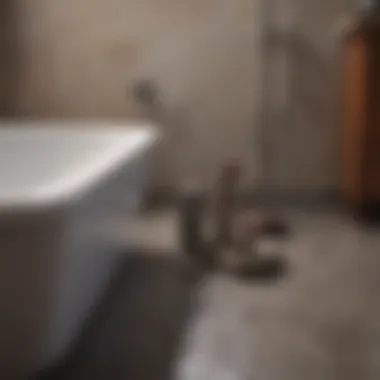
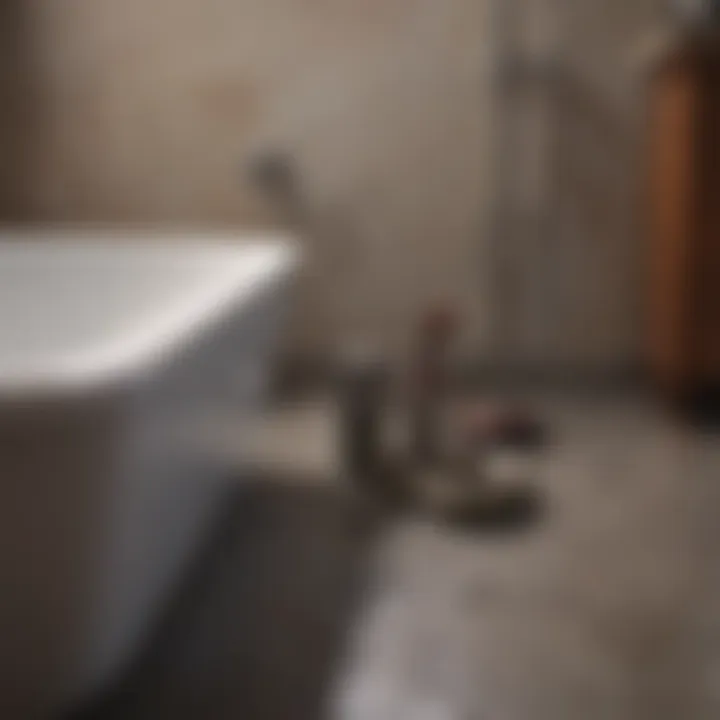
The salt and boiling water solution effectively tackles minor to moderate clogs. Users often remark on its ability to loosen grime and buildup that lead to slow draining. The combination of heat and salt has proven to provide a strong method against both grease and soap scum, which are common culprits.
However, homeowners should note that excessive heat can risk damaging certain plumbing materials. Thus, it’s essential to use this method judiciously. With regular application, this technique enhances drain functionality and can prolong the life of plumbing systems.
Utilizing Plumbing Tools
Using plumbing tools is often a homeowner's ace in the hole when tackling bathtub clogs. These tools can transform what might seem like a daunting problem into a manageable task. Knowing how to effectively use them not only saves time but also avoids the annoyance of recurring issues. When it comes to dealing with stubborn clogs, the right tool can make all the difference. Here, we’ll delve into two of the most valuable tools for unclogging bathtubs: the plumber's snake and the wet/dry vacuum.
Plumber's Snake
How to use
The plumber's snake, also known as an auger, is a flexible tool designed for reaching deep into pipes. Using it involves a few straightforward steps: first, insert the snake into the drain opening. You may need to rotate the handle to allow the tip to navigate around bends and twists within the pipes. Gradually push it deeper, feeling for any resistance that indicates a clog. Once resistance is felt, cranking the handle helps in breaking up the clog, allowing water to flow through again.
This method is popular because of its mechanical advantage. The snake's design lets it reach places where a typical plunger might not, making it effective against hairballs and soap scum build-up. However, one should be cautious, as aggressive use can potentially scratch or damage pipes, especially older ones.
When to choose this method
Choosing to use a plumber’s snake is often best for stubborn clogs that don’t respond to simpler remedies. If you find that your typical methods, like plunging, have been ineffective, it might be time to take the plunge—figuratively speaking—into more advanced tools. A key aspect of the plumber's snake is its adaptability. It can be used on different drain types, not just bathtubs.
Using it can be particularly advantageous in cases of deep-rooted clogs. If water isn’t draining at all, opting for a snake might save the day. On the flip side, it does require some skill, especially when finessing it through intricate plumbing. Newbies might find it a tad intimidating, but with a little patience, it’s certainly manageable.
Wet/Dry Vacuum
Operational steps
The wet/dry vacuum can be a surprising ally in the battle against bathtub clogs. To use it effectively, you should first ensure that it’s set to wet vacuum mode. Then, create a tight seal around the drain using the vacuum nozzle. This might require a bit of creativity with towels or duct tape to prevent air from escaping. Once sealed, turn on the vacuum and allow it to suck out any standing water and debris.
This method is particularly effective for larger clogs, as it can help in lifting out hair and other material causing the blockage. One nice element of using a wet/dry vacuum is its speed. You can often clear a clog much quicker than through repetitive plunging.
Limitations and advantages
The wet/dry vacuum has its own set of limitations and advantages. On the plus side, it’s very effective for both solid and liquid blockages, providing versatile use for many types of clogs around the home. You can also use it for other clean-up tasks, turning it into a multi-use tool. However, it’s not designed for every situation. If the clog is too far down the line, the vacuum might have difficulty reaching it.
Additionally, if you don't have a wet/dry vacuum at hand, it can be a hassle to acquire one, which leads to delays in dealing with the clog. So, while it's a fantastic tool, ensuring it’s in your inventory and knowing how to use it effectively can enhance your home maintenance arsenal significantly.
Next time you face a stubborn clog, consider reaching for these plumbing tools. They can often save you from having to call in professionals, preserving both your time and finances.
Chemical Drain Cleaners
When it comes to tackling bathtub clogs, chemical drain cleaners often rise to the surface as a viable option. Methods like home remedies are fine and dandy, but sometimes, you need the heavy artillery to break down those stubborn blockages. With the right chemical cleaner, you can restore that glorious flow of water in your tub without requiring extensive plumbing work.
That said, while chemical drain cleaners can be effective, they come with their own sets of perks and pitfalls. Understanding these cleaners means weighing their benefits against safety concerns, ensuring that you can effectively combat clogs while also protecting yourself and your plumbing system. Here’s what you need to know.
Types of Chemical Cleaners
Alkaline drain cleaners
Alkaline drain cleaners are a popular choice for many folks facing a clogged bathtub. This type of cleaner generally contains sodium hydroxide or potassium hydroxide, which effectively dissolves organic matter such as hair and soap scum. This makes alkaline cleaners quite appealing when you think of their ability to handle typical bathtub blockages.
A standout characteristic of alkaline cleaners is their strong base nature, which allows them to break down clogs quickly. They tend to be favorably viewed due to their effectiveness in tackling greasy build-ups that are notorious in bathrooms.
However, it's important to tread carefully with this type of cleaner. If left too long in the pipes, they can cause damage, wearing down the material of the pipes over time. Balancing usage frequency and quantity is key.
Acidic drain cleaners
On the flip side, acidic drain cleaners are designed to do the opposite of their alkaline counterparts. Typically featuring sulfuric or hydrochloric acid, these cleaners are no laughing matter. They work wonders on mineral deposits and can clear away the toughest, crunchy clogs.
The primary advantage of acidic cleaners lies in their ability to deal with the hard stuff that other cleaners might leave behind. If you've got build-up from mineral usage—like those pesky lime scales—these cleaners are champs when it comes to dissolving that material.
Like alkaline options, acidic cleaners also require caution. They can create fumes that are less than pleasant, and they can potentially corrode pipes if not used properly. Always read the labels and use with care; prioritizing safety is a must.
Enzymatic options
If you're looking for something a little more eco-friendly, enzymatic drain cleaners could be right up your alley. Instead of relying on harsh chemicals, these options utilize natural enzymes and bacteria to break down organic waste.
The key highlight of enzymatic cleaners is their non-corrosive nature. They work gently on your plumbing system while being effective at reducing build-up from hair and soap. Plus, their environmentally friendly approach is a big win for those concerned about chemicals polluting our waterways.
The only downside? They often take longer to show effects. Immediate results aren’t guaranteed, and if you’re dealing with a particularly stubborn clog, you might find yourself waiting a while before you see improvement.
Safety Precautions
With great power comes great responsibility. Chemical drain cleaners can handle clogs with ease, but safety measures are paramount.
Protective gear
When using these powerful solutions, don’t skimp on the protective gear. Goggles, gloves, and even masks can be lifesavers when dealing with harsh chemicals. An important aspect of protective gear is its role in preventing skin irritations and protecting your eyes from splashes.
A notable characteristic of protective gear is its ability to provide peace of mind. Knowing you’re shielded from potential harm allows for a more effective cleaning process. However, folks sometimes underestimate the importance of this precaution, leading to painful accidents. Don’t be that person—gear up!
Proper ventilation
Another vital safety measure is ensuring proper ventilation in the area where you’re using the cleansers. Many chemical cleaners emit fumes that can be hazardous if inhaled in large quantities. Adequate airflow helps prevent inhaling toxic substances, which can lead to headaches or respiratory issues.
By prioritizing proper ventilation, you enhance both your safety and cleaning effectiveness. If you’re working in a smaller bathroom, crack a window open or run a fan to keep the air circulating. Ignoring this step could result in a not-so-pleasant experience.
Chemical drain cleaners can effectively tackle clogs, but safety is non-negotiable. Equip yourself and your space to handle these powerful solutions wisely.
When to Call a Professional
Knowing when to reach out to a professional plumber can save you not just time, but also a good chunk of change. While many homeowners like to tackle bathtub clogs on their own, certain situations warrant the expertise of a trained technician. Recognizing how severe the issue really is is crucial. If you've tried various methods and still face persistent issues, it might be time to call in the cavalry.
Identifying Severe Issues
Persistent clogs
Persistent clogs are a major red flag. These are clogs that simply refuse to budge, no matter how many DIY techniques you throw at them. The constant battle between your drain and whatever’s clogging it can lead to increased wear on pipes and more extensive damage. Recognizing persistent clogs is key, as they often indicate underlying issues. Something might be up with the plumbing system itself, whether it's a collapse or a more serious blockage far down the line.
The unique challenge with these clogs is they tend to develop over time, making them hard to spot in their infancy. If you're consistently dealing with slow drainage or repeated blockages, calling a professional is a beneficial choice. They come equipped not only with specialized tools but also with the know-how to diagnose the problem accurately. Ignoring persistent clogs may lead to bigger issues later on, including costly repairs.
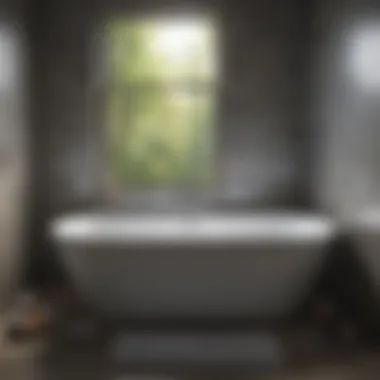

Significant water damage
Significant water damage is a consequence of prolonged plumbing issues and can affect both the integrity of your walls and flooring, as well as your health. Water damage can breed mold and mildew, risking respiratory issues and further structural problems in your home.
The key to understanding water damage lies in its silent onset; it might not be immediately noticeable. Yet, over time, the soggy smell or peeling paint speaks volumes. If you ever find yourself in this situation, getting a professional involved becomes important not just for repairs, but also for assessing the damage already done. A plumber can trace the source of leaks and make sure any underlying issues are addressed properly. With all that said, catching significant water damage early can make a world of difference in the overall health of the home.
Selecting the Right Plumber
Taking the time to select the right plumber is essential for addressing those stubborn clogs effectively. You might think any old plumber will do, but there’s more to it than that. Getting the right one can be the difference between a simple fix and a financial headache.
Research tips
Researching potential plumbers is a vital step that many overlook. You can start by checking online reviews, asking neighbors for recommendations, or looking on specialized platforms like Yelp or Angie’s List. The today’s digital age puts a treasure trove of information at your fingertips, so take advantage of it.
A well-researched choice can lead to many benefits, including fair pricing and timely service. Plus, knowing a plumber’s reputation beforehand gives you insight into their reliability. In this regard, you want to ensure that you’re making an informed decision without being in a hurry.
Questions to ask
Before hiring a plumber, arm yourself with a set of well-thought-out questions. For instance, inquire about their experience with your specific problem. Ask about their licensing and insurance status, as well as warranties for their work. It's also important to discuss their approach to safety and if they offer assessments before beginning a job.
The distinctive feature about asking questions lies in the information you gather. These answers can illuminate the plumber’s skill level and integrity, so don’t shy away from digging deeper. Rather than just hiring the first name that pops up, this step allows you to ensure that you align with a professional who will resolve your plumbing issues effectively.
Remember: Investing time in researching can save you both heartache and money down the line.
The Economic Implications of Clogs
Bathtub clogs may seem like a mere inconvenience, but their economic implications stretch far beyond just a simple annoyance. Addressing this issue promptly can save homeowners significant amounts of money in the long term. Not only do clogs necessitate repairs, but they can also lead to higher utility bills and, ultimately, a decrease in the overall value of the home. Understanding these economic repercussions helps reinforce the importance of maintaining a clear drainage system.
Costs Associated with Frequent Clogs
Frequent clogs can be a heavy burden on your wallet in various ways.
Repair expenses
Repair expenses associated with clogged bathtubs can add up quickly. These costs often arise from hiring professionals who may need to come to your home to address the jam. Depending on the severity of the blockage, repairs could range from simple snaking to more extensive pipe replacements. The key characteristic of repair expenses is that they tend to be unpredictable. One day, you may casually rinse your hair down the drain, and the next you find yourself faced with a mound of bills for emergency plumbing services.
This aspect of repair expenses highlights why waiting until the situation worsens is a poor choice. Engaging in timely, preventive maintenance can shield you from potential damages, drastically reducing those repair costs. By keeping pipes clear, homeowners can avoid the headache and stress that comes with extensive plumbing issues.
Increased water bills
Another economic aspect directly tied to clogged bathtubs is the impact on water bills. When a drain is blocked, water has trouble flowing freely. As a result, you may find yourself using more water to fill the bathtub or do routine rinsing, which leads to inflated utility charges.
The unique feature of increased water bills often takes homeowners by surprise. These costs accumulate gradually, and one might not realize how drastic the effect is compared to simple drainage maintenance. The disadvantage here is two-fold: not only are you paying more than you should, but the clogs could also become worse, resulting in further costs down the line.
Investing in Preventative Measures
Investing in preventative measures is crucial when it comes to managing bathtub clogs effectively. It’s not just about saving money; it's about being proactive and avoiding bigger issues that might arise.
Long-term savings
When dealing with plumbing systems, long-term savings can be substantial. Preventive measures such as regular drain cleaning and using hair catchers can minimize the frequency of clogs. By comparison, the relatively small investment in these simple tools can save you hundreds of dollars in repair and maintenance costs over time. Moreover, adopting regular cleaning routines ensures that you avoid the pitfalls of neglecting those issues until they escalate.
People often overlook the long-term savings aspect, preferring to deal with issues as they arise. However, establishing a habit of maintenance can lead to significant financial relief in the future, ensuring a smoother plumbing system.
Enhancing home value
Finally, taking care of your plumbing also plays a vital role in enhancing home value. Any potential buyer will likely consider the condition of the home's plumbing as part of their evaluation. A well-maintained plumbing system can serve as a convincing selling point, showcasing that you're attentive to the property’s needs.
The key characteristic of enhancing home value is that it translates directly into financial gain. When a home is free from plumbing issues, buyers feel more secure and may be willing to pay a premium for it. This unique benefit of maintaining good drainage is often underrated, yet it helps homeowners not only enjoy their space in the interim but also reap rewards when it’s time to sell. As such, making sure there are no hidden damages from neglected clogs is a wise investment.
Ending
The significance of understanding how to effectively manage and prevent bathtub clogs cannot be overstated. Home maintenance is really the backbone of a smoothly functioning household. When we delve into the topic, it highlights not only practical solutions but also the proactive measures we can take to avoid future frustrations. The processes discussed throughout the article target various aspects of bathtub maintenance, reinforcing how a little attentiveness can save both time and money in the long run.
Summarizing Key Points
Importance of Prevention
The importance of prevention in maintaining clean, functional bathtubs is a key theme throughout this article. Prevention strategies, such as using drain screens and engaging in regular cleaning routines, significantly contribute to minimizing the risks associated with clogs. Preventative measures are not just about reacting to problems; they serve as a foundational practice that can keep your plumbing in better shape. The unique feature of prevention is its ability to form a habit—the more consistently you adhere to preventative techniques, the less likely you are to encounter significant issues down the line.
This concept is especially beneficial because it helps homeowners avoid the excessive costs that come with emergency repairs. Imagine the peace of mind you would have knowing that your bathtub is less likely to clog due to simple, yet effective, maintenance practices. This proactive approach creates a more enjoyable bathing experience, making prevention not only popular but a wise choice in the context of household upkeep.
Benefits of Timely Intervention
Timely intervention plays a critical role in managing bathtub clogs effectively. The quicker you can address a potential clog, the less damage it can cause. This can mean the difference between a simple DIY remedy and a costly repair job involving professionals. The immediacy of your response can be vital in mitigating issues such as water buildup, which often leads to structural damage.
A unique characteristic of timely intervention is the opportunity it provides to assess and resolve problems while they are still manageable. It not only enhances the functionality of your plumbing system but often reduces the overall costs involved in plumbing services. Being quick to act allows for a more educated choice of methods for unclogging, which can include everything from home remedies to more intensive plumbing tools, based on the severity of the issue.
Recommended Reading
Books on Home Maintenance
A sound collection of books on home maintenance serves as a valuable reference for individuals seeking to navigate the challenges of plumbing care, including tackling clogs. These texts often break down intricate tasks into manageable steps, explaining techniques clearly and providing illustrations or diagrams. One notable characteristic of such books is the breadth of knowledge they offer. Homeowners can gain insights not just on clogs, but on other related issues, enhancing their overall DIY skills. For example, "The Complete Guide to Home Repair and Maintenance" offers an extensive overview that many find beneficial.
What makes these books a popular choice is the structured approach they provide. They usually categorize problems and solutions, which can be a boon for someone facing a stubborn clog. However, some might find the information somewhat generic or lacking the personalization that comes with hands-on experience.
Websites for DIY Solutions
The internet is brimming with websites devoted to DIY solutions, making it easy to find targeted advice for specific problems, like bathtub clogs. These platforms are characterized by their accessibility and range of content, from step-by-step guides to user-generated tips. Websites like Apartment Therapy or This Old House offer practical solutions based on real-life experiences. Their unique feature lies in the community-driven aspect, where users share insights and success stories, creating a peer support network.
The advantages of these websites include constant updates and varied perspectives. However, information can vary in reliability, so it's essential to cross-reference advice with multiple sources to ensure credibility.
Online Tutorials and Videos
Platforms to Explore
Online video platforms such as YouTube have revolutionized the learning process for DIY projects. These platforms make visual learning possible, allowing viewers to see the techniques in action. One key aspect of these platforms is the variety of content creators, from professionals to enthusiastic amateurs, contributing diverse approaches to home maintenance. For instance, a plumber might offer expert insights on using a plumber's snake effectively, which can be particularly advantageous for those unsure of how to proceed.
The unique feature of video tutorials is their ability to demonstrate techniques dynamically. Viewers can pause, rewind, and re-watch critical steps – making complex tasks feel more approachable. The downside, however, can be the overwhelming amount of information available, which might lead to confusion without a clear sense of direction.
Content Recommendations
When it comes to finding focused content, certain videos stand out due to their clarity and detail. Look for tutorials that not only explain the process but also consider common pitfalls and solutions. A key highlight of these recommendations is their practical relevance. Videos that target common clogging issues can save time by providing direct advice tailored to specific situations. For example, tutorials that combine engaging visuals with concise explanations can enhance understanding significantly.
While it is advantageous to have access to various content types, ensuring the quality and accuracy of the information should not be overlooked. Opt for reputable channels with positive reviews and a history of delivering reliable guidance.
Taking the time to consult additional resources can drastically elevate your home maintenance skills, especially regarding effective methods for removing bathtub clogs.



